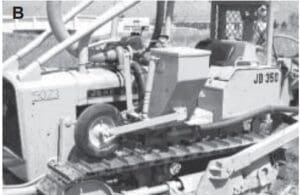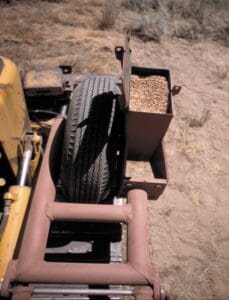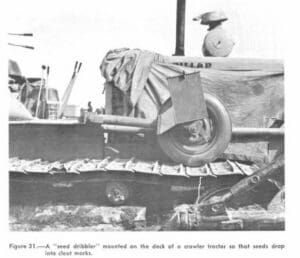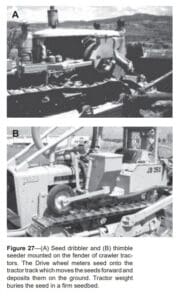Description
Seed dribblers are seeders built to be mounted on tractors, dozers, or bullhogs. The drive wheel is positioned on the top of the track and driven by it. Seed is gravity fed, deposited on the tracks, carried forward, dropped on the soil and pressed into the soil. Seed is distributed onto or in front of the track to be pressed into the seedbed. The tractor weight creates a firm seedbed and the track cleats create small water-catchment depressions. Dribblers are useful for planting species that require firm seedbeds or when seed is in short supply or costly. They are useful for planting shrub and forb seed separately from more rapidly growing grasses. They are also useful for small seeded species such as rabbitbrush, sagebrush, and many forbs that require minimal coverage. Dribblers can be used with other operations such as cabling.
Wheel-Drive type dribblers are often used to interseed species such as bitterbrush and fourwing saltbush. This version is the original wheel drive design that uses a wheel rolling across the track to drive the seed metering.
Application
Hansen Seeder
The Hansen Seeder is a seed dribbler with a fluted shaft seed-metering device moves the seed out of the dribbler. The seeding rate is determined by seed size and position of an adjustable gate over the fluted shaft. Because it is gravity fed, the Hansen seeder does not fluffy, plumed, or trashy seed well.
Thimble Seeder
The Thimble seeder has a spoked wheel with small cups attached to the spokes rotates through the seed to fill the cups. Seed from the cups is dropped through an opening and deposited on the tractor tracks. The seeding rate is determined by the size of the cups and the number of spokes with cups attached. The thimble seeder handles all types of seed. These seeders can be modified to operate with scalpers and to dispense seeds within the scalp.
Considerations:
- Holes usually need to be drilled into a dozer or bullhog to attach the dribbler. So they cannot be used with rented equipment.
- Because this is associated with the tracks of the dozer, planting spacing is wide.
- Metering and calibration is very rough and influenced by vehicle bouncing and shaking that occurs.
- The drive wheel can be very loud for the operator.





